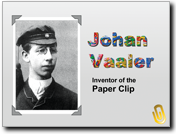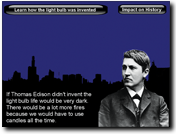
Students will learn about the value of scientific thinking as they study inventions and practice research and writing skills to create a Web site about an inventor.
App: Share™

Technology is all around us, and not only in cell phones, computers, and MP3 players. Technology is the application of science to solve practical problems. The result is usually an invention, a new product or a process that makes life better. In this project, your class will create a Web site to showcase advancements in everyday life made by famous, and some not-so-famous, inventors.
What would life be like without inventions? Because students are surrounded by technology, begin by focusing on inventions they use every day. Then, encourage students to think of inventions that are not related to computers. After brainstorming several inventions, ask students to describe how their lives might be different without them.
Share with your students some common tools like pencils, scissors, and paper clips. The modern pencil was invented in 1564 with the discovery of graphite. We do not know who invented scissors! Ancient Egyptians probably came up with the idea, which was modified by the Romans into the form we have today. The paper clip was not invented until 1899, only a year before the 20th century!
This process is designed to generate curiosity in your students about the origin and inventors of products they use every day. You may want to read E. L. Konigsburg’s Samuel Todd’s Book of Inventions. Depending on the age of your students, you may want to share this unique video about life without basic inventions. Let your students know that they will create Web sites that celebrate common inventions and some not-so-common inventors.

Assign an inventor to each student, or let the students choose an inventor they wish to research. For example:
Have students research basic who, what, when, where, and how information about their inventors. Their research should also help them describe the historical, social, economic, and scientific impacts of the inventions. To help students better understand events that help shaped each inventor’s perspective, have each student create a timeline of significant events in their inventor’s life.
Let students know that they will transform their research into a Web site about the inventor. You may want to give students guidance on what information they should include on each page of their project, such as:
Upload all of the sites to the same location and create a menu page that links to each inventor site. You may also want to place this resource in a school media center or advertise some fun facts students learned on your school’s news program or audio announcements.
Ask each student to share the highlights from their research with the rest of the class. Ask students to share both basic information and how they think the inventions changed society and impacted history.

As you brainstorm life without inventions, you can assess students’ prior knowledge. You will be able to evaluate their note-taking, summarizing, and information literacy skills as they research information for their sites
Their site and oral presentation will also help you assess their understanding of the impact of each inventor’s invention.
Bender, Lionel. Eyewitness Books: Invention New York, NY: Alfred A. Knopf, 1991. ISBN: 0756610753.
Konigsburg, E. L. Samuel Todd’s Book of Inventions. ISBN: 0689832028.
Lambert, David. Great Discoveries and Inventions. ISBN: 0816010625.
Invent Now invent.org
Zoom Inventors and Inventions http://www.zoomschool.com/inventors
About.com: Famous Inventors http://inventors.about.com/od/famousinventors
Writing Standards
Text Types and Purposes
1. Write arguments to support claims in an analysis of substantive topics or texts, using valid reasoning and relevant and sufficient evidence
2. Write informative/explanatory texts to examine and convey complex ideas and information clearly and accurately through the effective selection, organization, and analysis of content.
Production and Distribution of Writing
4. Produce clear and coherent writing in which the development, organization, and style are appropriate to task, purpose, and audience.
6. Use technology, including the Internet, to produce and publish writing and to interact and collaborate with others
Research to Build and Present Knowledge
7. Conduct short as well as more sustained research projects based on focused questions, demonstrating understanding of the subject under investigation.
Speaking and Listening Standards
Presentation of Knowledge and Ideas
5. Make strategic use of digital media and visual displays of data to express information and enhance understanding of presentations.
Students compare and contrast different stories of accounts about past events, people, places, or situations, identifying how they contribute to our understanding of the past.
6. Creative Communicator
Students communicate clearly and express themselves creatively for a variety of purposes using the platforms, tools, styles, formats and digital media appropriate to their goals. Students:
a. choose the appropriate platforms and tools for meeting the desired objectives of their creation or communication.
b. create original works or responsibly repurpose or remix digital resources into new creations.
d. publish or present content that customizes the message and medium for their intended audiences.

Follow us on Instagram for daily inspiration

Create a thought web, cluster, flowchart, or other graphic organizer for a lesson
8 first projects to get students using technology
Creative, digital book reviews
Fun and powerful ideas with animated characters

Wixie
Share your ideas, imagination, and understanding through writing, art, voice, and video.

Rubric Maker
Create custom rubrics for your classroom.

Pics4Learning
A curated, copyright-friendly image library that is safe and free for education.

Wriddle
Write, record, and illustrate a sentence.

Get creative classroom ideas delivered straight to your inbox once a month.
Topics